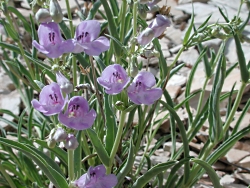
Penstemon albifluvis
Courtesy and Copyright Robert Fitts, Photographer
While here, they’ll be searching the Uinta Mountains for penstemons native to that area.
If you’ve ever hiked in the rugged, dry areas of Utah and come upon a vibrant flower with hues of red, purple, or blue, and wondered how such a beautiful plant could survive in such a desolate place – you may have found one of Utah’s native penstemons.
Over 100 full species or sub-species of the plant are native to the beehive state. They thrive in hot conditions and require very little water.

hunting penstemons
in the Unitas
Courtesy and Copyright Robert Fitts, photographer
The common name for penstemon is beardtongue, due to the staminode that grows out of the center of the flower and looks like a hairy tongue.
In the spring, hikers can see beardtongue growing on mountain ledges, budding on desert floors, and rising from oil shale formations. Even people stuck in the city can see these native flowers blossom along urban roads since Utah Division of Transportation includes penstemon seeds in the mixtures used to restore vegetation along new and reconstructed roads.
Dr. Noel Homgren, Senior Curator Emeritus at the New York Botanical Garden explains, “Although penstemon distribution [stretches from] southern Alaska to northern Guatemala; Utah is the Center of Diversity for penstemon. There are more species of penstemon in Utah than any other state in the Union.”

Penstemon grahamii
Courtsey and Copyright Robert Fitts, photographer
With the increasing popularity of water-wise landscapes, many native penstemons can now be purchased in flower shops. You can have a little bit of native Utah growing right in your own back yard.
Firecracker and Wasatch are two popular penstemon choices. Both thrive in dry landscapes and require no fertilizer. Fertilizer actually shortens the life of penstemons.

Courtesy & Copyright Dr Tom Edwards, Photographer
“If you’ve ever seen a hummingbird war where two or more hummingbirds fight over a plant it’s fascinating sight.”
The Wasatch Beardtongue has rich colored flowers with hues of purple, blue and lavender that bloom upward. It’s a favorite for the bumblebee. If you come close to these flowering plants you can hear the low humming of the bees hard at work.
Some native penstemons are quite rare and found in very limited areas. Two of these are the Graham and White River penstemons, found only in the oil shale outcrops of the Uintah Mountains.
To help preserve these rare flowering plants, Utah’s Department of Natural Resources, through the Division of Wildlife Resources, partnered with USU to use modeling as an aid to determine where the rare flowers grow.
By using survey data from the Utah Heritage Program, which tells where the rare plants have been found, the data is entered into the model and fined tuned so it can more accurately tell the researchers other locations where the rare plants may be.

Penstemon grahamii
In Uinta Shale
Courtsey and Copyright Robert Fitts, photographer
Often when I come upon a rare pentsemon, I’m so relieved and happy that I drop to my knees and with my hands in the dirt examine it closely.
“Every piece of data we gather goes back into the model to refine it.”
Dr. Tom Edwards, Research Scientist with the U.S. Geological Survey, professor in the Department of Wildland Resources, and Principal investigator on the project, said – once we have the models and understand where the rare plants are, it allows management agencies to work with their stakeholders (who include tribal nations, energy groups and ranchers) to decrease the impacts they have on these rare plants.
Wheeler adds, “It’s been helpful to find…rare penstemons which are a conservation priority because it either helps with conservation actions or in a best case scenario finds enough plants so they no longer need as much protection.”
Utah residents who would like to add penstamon to their yards, can go to the Utah Native Plant Society’s website, to find the closest supplier in their area.
Edwards adds, “Penstemons bloom at different times of the year so if you plan carefully you can have vibrant rotating color in your gardens all summer long.”
To become a Penstemaniac simply go to The American Penstemon Society website and join.
This is Shauna Leavitt for Wild About Utah.
Credits:
Photo: Courtesy & Copyright Dr Tom Edwards
Photo: Courtesy & Copyright Dr Robert Fitts
Text: Shauna Leavitt, Utah Cooperative Fish and Wildlife Research Unit, Quinney College of Natural Resources, Utah State University
Sources & Additional Reading
American Penstemon Society: https://penstemons.org/
Utah Native Plant Society: https://www.unps.org/index.html
Loyola, Deena, Penstemon Conservation Agreement Finalized, Trust Lands Administration, State of Utah School and Institutional Trust Lands Administration, Aug 6, 2014, https://trustlands.utah.gov/penstemon-conservation-agreement-finalized/
Graham’s and White River Beartongues, Species, US Fish and Wildlife Service, Mountain-Prairie Region, https://www.fws.gov/mountain-prairie/es/grahamsAndWhiteRiverBeardTongue.php
Penstemon grahamii D.D. Keck, Uinta Basin beardtongue, Plants Database, Natural Resources Conservation Service (NRCS), United States Department of Agriculture (USDA), https://plants.usda.gov/core/profile?symbol=PEGR6
